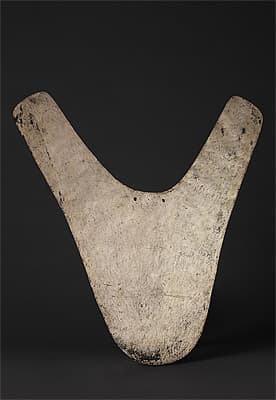
VICÚS culture North coast 100 BC – 400 AD
Pectoral 100 BC - 400 AD gold, silver, copper55.0 (h) x 55.0 (w) cm Museo Larco, Lima Photograph: Daniel Giannoni
Stark bold shapes are typical of Vicús regalia. Small holes indicate that ornaments would have been attached to cloth. Vicús metalworkers are famed for their advanced use of electroplating. Most of their metalware was copper, with an extremely thin layer of gold—about 0.008 mm—covering the surface. This was achieved by submerging the object in a solution of gold and corrosive minerals that was heated to more than 500 degrees. The result appeared to be pure gold.
Stark bold shapes are typical of Vicús regalia. Small holes indicate that ornaments would have been attached to cloth. Vicús metalworkers are famed for their advanced use of electroplating. Most of their metalware was copper, with an extremely thin layer of gold—about 0.008 mm—covering the surface. This was achieved by submerging the object in a solution of gold and corrosive minerals that was heated to more than 500 degrees. The result appeared to be pure gold.
Stark bold shapes are typical of Vicús regalia. Small holes indicate that ornaments would have been attached to cloth. Vicús metalworkers are famed for their advanced use of electroplating. Most of their metalware was copper, with an extremely thin layer of gold—about 0.008 mm—covering the surface. This was achieved by submerging the object in a solution of gold and corrosive minerals that was heated to more than 500 degrees. The result appeared to be pure gold.

